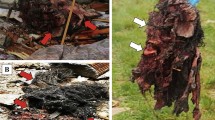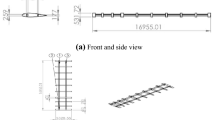Abstract
The Thor (Test Device for Human Occupant Restraint) dummy has been designed by the National Highway Traffic Safety Administration (NHTSA) in order to provide an advanced frontal crash test dummy that incorporates improved biofidelic features and significantly expanded instrumentation. The development of a finite element model of the Thor dummy under Radioss was performed in order to provide a numerical tool for crash safety research which can be used in combination with physical dummy. The Radioss Thor model was based on an accurate description of all components of the physical dummy and an extensive validation database of the model. This paper includes a general description of the dummy model, from mesh definition and modelling choices up to its validation and evaluation.
Similar content being viewed by others
REFERENCES
KHALIL, T B, LIN, T C. Simulation of the Hybrid III dummy response to impact by non linear finite element analysis, Stapp Car Crash Conference, vol. 103, N °?94, pp. 279, 1994
MIDOUM, D E, ABRAMOSKI, E, RAO, M K and KALIDINKI, R. Development of a finite element model of the side impact dummy, 37th Stapp Car Crash Conference, 1993.
THOLLON, L, ARNOUX, P J, KAYVANTASH, K, CAVALLERO, C, BRUNET, C. Human injury evaluation using Humos Radioss finite element model. International Journal of Crash Prevention and Injury Control, IRCOBI 2002.
THOLLON, L, BEHR, M, CAVALLERO, C, BRUNET, C. Finite element modelling and simulation of upper limb with radios, International Journal of Crashworthiness, 7(3), pp. 269-284, 2002.
ARNOUX, P J, KANG, H S, KAYVANTASH, K. The Radioss Human model for Safety, Arc hives of Physiology and Biochemistry, vol. 109, pp. 109, 2001.
FOUNTAIN, M, HAPPEE, R, WISMANS, J, LUPKER, H and KOPPENS, W. Modelling of crash dummies for numerical simulation, International Conference on the Biomechanics of Impacts, pp401-420, 1996.
HASEGAWA, J, MOTOJIMA, H, OGAWA, Y, ANDO, K and HAUG, E. Development of a finite element model of the side impact dummy and application for the side impact protection, the 15th International Technical Conference on Enhanced Safety of Vehicles, Proceeding vol 2, pp 1342-1354, 1996.
PAL, C, ICHIKAWA, H, SAGAWA, K and HAGIWARA, I. Development of finite element side impact dummy (SID) model based on dynamic behaviour, the 15 th International Technical Conference on Enhanced Safety of Vehicles, Proceeding vol 2, pp 1355-1364, 1996.
RÑCKERT, J, MARCAUL T P, S CHLOSSER, J, LASRY, D, HAUG, E, ROGER, J, CESARI, D, BERMOND, F and BOUQUET, R. Advances in finite element modelling of the Eurosid-1 dummy, the 14th International Technical Conference on Enhanced Safety of Vehicles, Proceeding vol 2, pp 1058-1064, 1994.
STANLY, H and MERTZ, H J. Hybrid III:The first human like crash test dummy, SAE PT-44, 1994
KAYVANTASH, K and ZENG, Q. The Radioss Hibrid III users Manual, MEC ALOG, 1999.
GESAC, Thor Alpha user 's manual-Trauma assessment device development program, G ESAC-NHTSA, 2001
SHAW, G, CRANDALL, J and BUTCHER, J. Biofidelity Evaluation of the Thor Advanced Frontal Crash Test Dummy. Proc eedings of the IRCOB I Conference, 2000
JOHNSON, G, COOK, W. A constitutive model and data for metals subjected to large strainsn high strain rates and high temperatures, 7th symposium on Ballistics, The Hague, 1983.
KAYVANTASH, K. Inverse identification method with Radioss DSS software, International Radioss Users Conference, 2001.
LEMAITRE, J, CHABOCHE, J L. Mécanique des Matériaux solides, Dunod, 1996.
OGDEN, R W. Non linear elastic deformations, Ellis Horwood, 1984.
WILLKENMULLER, G, KAYVANTASH, K. Radioss theoretical manual, MECA LOG, 1999.
GESAC, Thor Alpha certification procedure-Version 1.1, GESAC-NHTSA, 2001.
MELVIN, J and WEBER, K. Task B final report. U MTRI-85-3. University of Michigan Transportation Research Institute, 1985.
CFR, Code of Federal Regulations. Title 49, Part 572, Subpart E, 1998.
NEATHERY, R. Analysis of chest impact response data and scaled performance, 1 8 th STAPP car crash conference, 1974.
YOGONANDAN, N, PINTAR, F, KUMARESAN, S, HAFFNER, M and KUPPA, S. Impact biomechanics of the human Thorax abdomen complex. International journal of Crash, Vol 2, No. 2, pp. 219-228, 1997.
NUSHOLTZ, G and KAIPER, P. Abdominal response of steering wheel loading. P roceedings of the 14 th International Conference on Experimental Safety Vehicles, 1994.
CAVANAUGH, J, NYQUIST, G, GOLDBERG, S and KING, A. Lower Abdominal Tolerance and Response. Proc eedings of the 30th Stapp Car Crash Conference, 1986.
HORSCH, J and PATRICK, L. Cadaver and Dummy Knee Impact Response. P roceedings of the 20th Stapp Car Crash Conference. SAE Paper #760799, 1976.
Rights and permissions
About this article
Cite this article
Arnoux, P.J., Joonekindt, S., Thollon, L. et al. Radioss finite element model of the Thor dummy. International Journal of Crashworthiness 8, 529–541 (2003). https://doi.org/10.1533/ijcr.2003.0256
Issue Date:
DOI: https://doi.org/10.1533/ijcr.2003.0256




